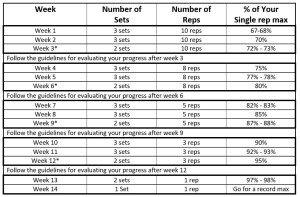 Linear loading has produced a huge amount of powerlifting champions over the past half century. It was especially popular all the way through the 1990’s and it is still somewhat popular today. Linear loading basically refers to a training cycle in which weight is added to your lifts on a regular basis according to a predetermined schedule. The cycle generally starts out with lighter weight that can be done with higher reps and proceeds to increasingly lower reps as the weight is increased over time. The schedule may vary according to the specific program that is being followed. Some schedules may call for weight increases every workout. This would most commonly be used for beginner or intermediate training, and is also used for a method called, Hypertrophy Specific Training (also called HST) which was originated by Bryan Haycock. More often, linear loading consists of weekly increases of weight, and sometimes it refers to increasing the weight from block to block when using training blocks that last anywhere from three to six weeks in length.
Linear loading has produced a huge amount of powerlifting champions over the past half century. It was especially popular all the way through the 1990’s and it is still somewhat popular today. Linear loading basically refers to a training cycle in which weight is added to your lifts on a regular basis according to a predetermined schedule. The cycle generally starts out with lighter weight that can be done with higher reps and proceeds to increasingly lower reps as the weight is increased over time. The schedule may vary according to the specific program that is being followed. Some schedules may call for weight increases every workout. This would most commonly be used for beginner or intermediate training, and is also used for a method called, Hypertrophy Specific Training (also called HST) which was originated by Bryan Haycock. More often, linear loading consists of weekly increases of weight, and sometimes it refers to increasing the weight from block to block when using training blocks that last anywhere from three to six weeks in length.
A linear loading cycle may last as little as three weeks. This type of short loading cycle is often called a wave. The Westside lifters use a three week loading wave for their dynamic speed training. The wave is then started over again every three weeks. More often, a linear loading cycle lasts at least 6 weeks and may go as long as 18 weeks. At the end of this article, you will find a linear cycle that is 14 weeks long.
Effective Loading is Dependent on Adding the Right Amount of Weight
One of the keys to linear loading is to start with the right amount of weight and add the right amount of weight each time weight is added. If the additions of weight are too small, the training never becomes challenging enough. If the additions of weight are too big, a lifter will not have enough strength to complete the required number of reps for each set of a given workout. This can happen to anyone on occasion, but if it happens on a regular basis throughout a training cycle, the training will prove to be ineffective. One of the most challenging aspects of linear loading is to find the right amount of weight to use in every single workout.
Two Methods For Planning a Linear Loading Cycle
There are two common methods that lifters use when planning how much weight to start with and how much weight to add each week throughout a training cycle. The first way is for a lifter to set a goal in terms of the amount of weight and reps that they are shooting for in the very last workout of the training cycle. From there, the lifter will count back by even intervals of weight from week to week to determine how much weight will be used for a given lift each week. The lifter may count back by just five pounds each week if they are a beginner or an intermediate. As they become stronger, the lifter may plan cycles that demand an increase of 10 pounds per week. If a lifter becomes enormously strong with the ability to lift 500 pounds or more for a given lift, he may need to increase by 15 or even 20 pounds per week; it all depends on the strength of the lifter and how long they want their training cycle to last. For example, if a lifter’s goal is to be able to lift 400 pounds for a single rep by the end of a 14 week training cycle, he may start with a 270 pound squat during the first week of the cycle and add 10 pounds per week until he reaches 400 pounds the last week of a 14 week cycle.
A second method for determining how much weight to use each week is to use the percentage method. The percentages are based on how much weight a lifter can use for a single rep max lift. For example, if his max lift for a single rep in the squat is 300 pounds, and the prescribed weight for the first week is 65%, then the lifter must use 65% of 300 pounds which is 195 pounds. The prescribed percentages will increase from week to week and the lifter simply follows the prescribed percentages listed. This is the type of linear loading cycle that is shown at the end of this article.
Knowing How to Make Adjustments to the Loading Process
The biggest problem with any linear loading program is that a lifter’s strength level may not truly match the amount of weight and reps listed from week to week. It takes a lot of experience to find a loading cycle that matches your individual strength throughout the whole cycle. This means that a system that makes room for adjustments must be built into the cycle in case the weights are either too challenging or not challenging enough.
In the 14 week cycle list below, increasingly heavier percentages are used from week to week. If you look at the cycle, you will notice that 10 reps are used for the first three weeks. The first week should not be extremely hard or you will not be able to add on weight and still complete ten reps during the next two weeks. You should be able to do all ten reps using a steady even rep pace your first week without having to slow your rep speed on any reps at the end of the set. However, by your third week with ten reps, it should be quite challenging to perform ten reps. Your rep speed should slow down at the end of the set if you are truly pushing yourself. Use these guidelines for evaluating whether or not you need to adjust the single rep max weight that you are calculating your percentages from. Let’s look at some examples of when you would need to make adjustments.
When to Adjust The Prescribed Weights Up or Down
Let us assume that your single rep max for the squat is 300 pounds and that you are using this number to calculate your percentages. If you find that 10 reps are very easy the third week, you need to increase the max you are using for your calculations to 310 pounds or more when calculating your weekly percentages. On the other hand, if the you couldn’t even reach 10 reps with the weight you were using the third week, you need to decrease the max weight down to 290 or less when calculating your weekly percentages. Always adjust as needed throughout the cycle, because you may be gaining strength at a rapid rate which means that the max you are using for your percentage calculations will be constantly changing. It may also be that the max that you are using for your calculations isn’t truly your max and you either over-estimated or under-estimated your max and need to make adjustments to the max you are using for your calculations.
With this information in mind, the 14 week linear loading cycle listed below would be an excellent option if you are interested in trying a linear loading cycle.
Guidelines for Evaluation After Weeks 3-6-9-12
- If you reach one of the evaluation weeks (which refers to weeks 3, 6, 9, or 12) and the required number of reps feels easy, add 5 to 10 pounds to the single rep max that you are using to calculate your weekly percentages.
- If you did not have enough strength to perform the required number of reps during an evaluation week (which refers to weeks 3, 6, 9, or 12), subtract 10 or more pounds from the single rep max that you are using when calculating your weekly percentages.
If you are looking for a new linear loading program, you can give this one a try. Best of training to you.


